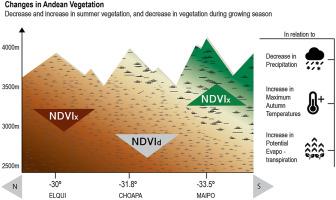Journal of Arid Environments ( IF 2.7 ) Pub Date : 2020-12-24 , DOI: 10.1016/j.jaridenv.2020.104397 Valeria M. Rudloff , José A. Rutllant , Alejandra Martel-Cea , Antonio Maldonado

|
The impact of future climate change on the native vegetation of subtropical Andes is relatively unknown. The semiarid region of north-central Chile (30–34°S) has experienced a mega-drought over the last decade, with a partial recovery during the 2015 El Niño year. To characterize the vegetation response to climate variability, we analyzed the seasonal precipitation, potential evapotranspiration, temperature extremes, and high-resolution normalized difference vegetation index (NDVI) data at five altitudinal floors above 2500 m.
We considered the bi-monthly maximum NDVI in austral summer (NDVIx) and the difference between NDVIx and that of two months prior (NDVId) to reflect the primary productivity throughout the growing season. We observed positive linear correlations between NDVIx and winter precipitation and negative ones with autumn/winter maximum temperatures at lower altitudes (the latter likely led to the negative correlation between NDVIx and potential evapotranspiration). The NDVIx showed clear latitudinal and altitudinal variability, with the southern region exhibiting an opposite NDVIx climate correlation pattern at altitudes greater than 3500 m. The NDVId correlations were more spatially uniform and showed similar patterns to those of NDVIx at lower altitudes. Precipitation declined at a rate of −45%/decade, which contributed to the −1.5%/decade and −5%/decade decline in NDVIx and NDVId, respectively. The positive NDVIx trends (1.5%/decade) above 3500 m in the southern region led to an early snowpack retreat, which was consistent with the temporal increase in autumn maximum temperature of 1.23 °C/decade. Our results suggest that ongoing climate change will have a negative impact on the high-altitude ecosystems of the semiarid Andes.
中文翻译:

智利高海拔半干旱安第斯山脉(30–34°S)的NDVI水热调制
未来气候变化对亚热带安第斯山脉原生植被的影响相对未知。智利中北部的半干旱地区(30-34°S)在过去十年中经历了特大干旱,在2015年厄尔尼诺年期间部分恢复。为了表征植被对气候变化的响应,我们分析了2500 m以上五个垂直高度的季节降水,潜在蒸散量,极端温度和高分辨率归一化植被指数(NDVI)数据。
我们考虑了夏季南方的两个月最大NDVI(NDVIx)以及NDVIx与两个月前的NDVIx之间的差异(NDVId),以反映整个生长季节的主要生产力。我们观察到NDVIx与冬季降水之间呈正线性相关,而与较低海拔地区的秋冬季最高温度呈负线性相关(后者可能导致NDVIx与潜在蒸散量之间呈负相关)。NDVIx表现出明显的纬度和纬度变异性,南部地区在海拔大于3500 m时表现出相反的NDVIx气候相关模式。NDVId的相关性在空间上更加统一,并且在较低高度显示出与NDVIx相似的模式。降水下降了-45%/十年,这导致了-1。NDVIx和NDVId分别下降5%/十年和−5%/十年。南部地区高于3500 m的NDVIx趋势为正(1.5%/十年)导致积雪提前退缩,这与秋季最高温度每十年十年1.23°C的时间增加一致。我们的结果表明,持续的气候变化将对半干旱安第斯山脉的高海拔生态系统产生负面影响。



























 京公网安备 11010802027423号
京公网安备 11010802027423号